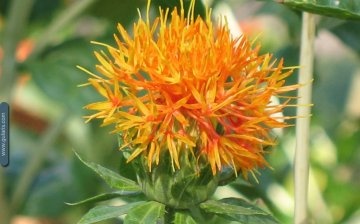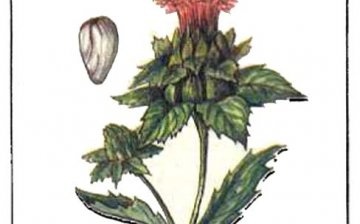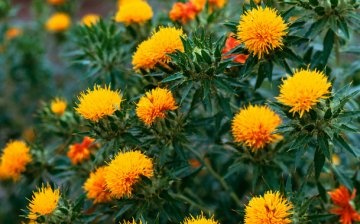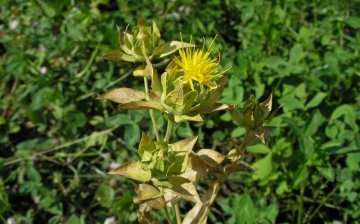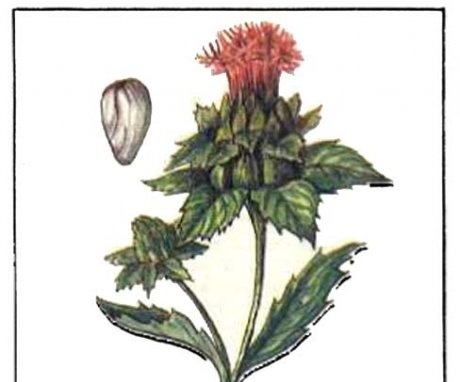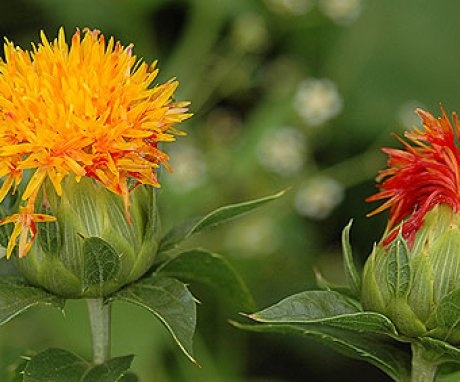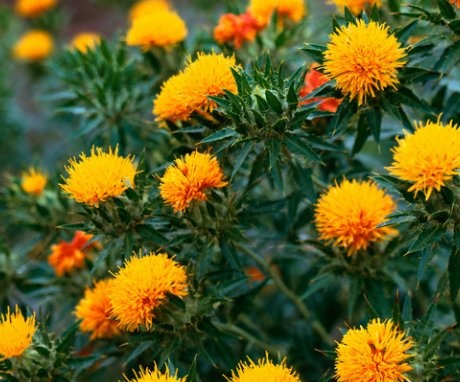Dyeing safflower: characteristics and secrets of plant growing
Dyeing safflower is a unique plant that can be used not only to significantly improve landscape design, but also to use it as a medicine.
Content:
- Description of the plant
- Safflower varieties
- Features of growing a plant
- Safflower diseases and pests
Description of the plant
Dyeing safflower belongs to the category perennial plants... It also belongs to the Asteraceae family.
This plant is characterized by:
- The presence of a bare erect stem, which can reach a height of 60 to 80 centimeters.
- Safflower has leaves of an oblong-ovoid shape, which are characterized by spiny-toothed, sequence, leatheriness, sessile.
- This plant is capable of flowering. It has large flowers that are placed in egg-shaped or spherical baskets.
- Each basket is located at the top of one branch.
- The originality of the flower is given by the tight closeness of the inner leaves of the wrapper.
- The flowers of this plant are characterized by filminess, closeness, entire edge, lance.
- The middle petals of the flower have a spiny-toothed appendage. The outer petals are characterized by elongation and foliage.
- The color of the flowers can be bright orange or yellow.
This plant has a five-toothed corolla and five stamens.
The anthers of this plant are soldered into a tube. A column also passes through it, which has a bifurcated stigma. The ovary appears from below and is characterized by unilocularity. This plant has fruits in the form of a tetrahedron, which has a hard and thick shell.
The dimensions of the fruit are quite small: the diameter is 3 millimeters, and the length is 7 millimeters. The fruit is characterized by the absence of a fly and at the same time it has an oblique scar. This plant blooms in July or August.
Safflower varieties
This plant can be conditionally divided into several varieties in accordance with the yield, growing season, the amount of oil in the seeds.
The most famous of them are:
- Steppe safflower.
- Professor Mashanov.
- Sunny safflower.
The flowering of the steppe variety of this plant begins in the middle:
- Its primary branch is of medium length.
- This plant has very few thorns, which provides a lot of convenience while caring for it.
- The seedling of this plant is white and medium in size.
The growing season of steppe safflower is 115 days. This plant is characterized by resistance to drought, shedding and lodging. Steppe safflower is not susceptible to diseases, which makes it the most profitable to grow.
Solar safflower has:
- Inflorescences in the form of a basket.
- This basket can have a diameter of 2.5 to 3 centimeters.
- One plant of this variety can have 10 to 25 baskets at a time.
- The leaves of this plant are covered with small needles.
- Sun safflower flowers are characterized by a yellow-orange color.
At the end of flowering, the petals of this plant turn red.
The fruit of this plant is in the form of achenes, which in appearance resembles sunflower seed... When the seeds ripen, they do not crumble, which allows you to collect a more complete harvest.
Safflower Professor Mashanov has:
- Inflorescences in the form of a basket.
- This plant has very few thorns, which provides a lot of convenience while caring for it.
- The fruit of this plant is in the form of an achene, which in its appearance resembles the achene of a sunflower.
- This plant is characterized by resistance to drought, shedding and lodging.
Features of growing a plant
Safflower belongs to the category heat-loving plants, which requires landing in well-lit and warm places. This plant is quite drought tolerant, so it does not require regular watering. Germination of seeds after planting safflower takes place at a soil temperature of 2-3 degrees.
In order to get seedlings faster, this plant must provide a soil temperature of 4-6 degrees. Safflower is characterized by an increased level of demand for heat during flowering and ripening.
Pollination of this plant is done with the help of insects.
The most productive helpers in this matter are bees. This is because the flowers are tubular. This allows the bee to freely penetrate each flower. Also, this plant is capable of pollinating on its own. Self-pollination significantly reduces yield levels.
Growing secrets:
- The preparation of the field for safflower should be carried out using the same technology as the preparation of the field for any spring culture, which is sown early. This plant is characterized by a lack of exactingness to its predecessors.
- In order to ensure a high yield of this plant, it is best to plant it after spring or winter grain crops.
- Safflower also grows and develops very well after row crops.
- If necessary, this plant can be planted after rapeseed, flax or corn.
- Phytosanitary considerations state that planting safflower after sunflower or in one place annually is strictly prohibited.
- After planting this plant in one place, this action can be repeated only after 4-5 years.
After safflower, fodder, grains and other crops can be grown, which will significantly increase their yield.
The planting of this plant must be carried out simultaneously with spring grain crops. In the event that you are late with the date of sowing safflower, it will significantly reduce its yield. It is necessary to plant safflower in the ground to a depth of no more than 5-6 centimeters.
Harvesting:
- Harvesting safflower should only be done when it is fully ripe. This is determined by the complete yellowing of all plants and baskets and the maturation of the seeds.
- In the event that the crops are clogged with weeds, then harvesting can be carried out by conveyor belt method.
- After harvesting, the seeds go through a stage of cleaning and drying (moisture should be 12 percent).
The seeds of this plant are rather difficult to separate from the sunflower. From all other seeds, safflower seeds can be separated very easily. The seeds of this plant are not capable of releasing a sticky resin, which restricts it from sticking together.
Safflower diseases and pests
Safflower is a fairly unpretentious plant to care for. Despite this, it can be damaged. various diseases and pests... The most common plant diseases are rust and ramularia.
Safflower rust is caused by rust fungi:
- This disease is characterized by the presence of pustules on the affected organs, which have different sizes and shapes.
- When cracking, a rusty powder is poured out of the plant, which consists of fungal spores.
- The presence of this disease is indicated by the presence of convex concentric spots, which are rusty-brown in color.
- These spots are located on the underside of the leaves.
- On the upper sides of the leaf, these spots are projected into specks of light yellow color.
- If this plant is severely affected by the disease, then petals may begin to fall from it.
- The causative agents of this disease can be carried by the wind, which indicates its rapid spread.
In order to destroy the disease, it is necessary to destroy the intermediate hosts of rust.
In order to destroy wintering uredo- and teiletospores, deep plowing of the earth is performed before planting. In order to increase the plant's resistance to this disease, it is necessary to carry out the appropriate agrotechnical eventand also cleanse the seeds with fugnicides. It is also necessary to spray the fugnicidamia on the plant itself after the leaves bloom.
Rumulariosis can affect old leaves of a plant:
- The disease affects the plant in the form of spots that appear on the edges of the leaf.
- The size of the spots is initially light green in color, which later turns into a grayish-white color.
- The diameter of the spots can be from 4 to 7 millimeters.
- The spots are irregular. They can be with or without a border.
- The border can be red or dark brown in color.
- In order to protect the plant from this disease, it is necessary to plow the land annually, as well as treat the seeds and the plant itself with fugicides.
As for pests, these plants can be affected by wireworms or scoops. These pests can affect not only safflower, but also other plants. The specific pests of this plant are the safflower fly and the sage scoop.
Sage scoop:
- Belongs to the category of lepidoptera. These butterflies overwinter in the upper layers of the soil.
- That is why, before planting a plant, it is necessary to treat the soil with fugnicides.
- The most active butterflies become after sunset. Initially, these pests skeletonize safflower leaves from underneath, and then gnaw holes of various sizes in them.
- To prevent damage to the plant by this pest, it is necessary to observe crop rotation and spatially isolate crops.
Safflower fly:
- Belongs to the category of diptera insects, the length of which is 4-5 millimeters.
- Females of this insect lay their eggs in safflower inflorescences, and feed on its fruits and ovaries.
- To combat this pest, it is necessary to sow this plant early.
- Before flowering, it is also necessary to destroy all wild-growing safflower that grows nearby crops.
- You can also use insecticides to combat this pest. Spraying is carried out during the budding period of the plant.
Safflower is a fairly useful plant.
Oil is extracted from it. Proper care of this plant will provide it very good yield... This plant is unpretentious to weather conditions. It easily tolerates drought, which does not affect the level of its yield. Due to such indicators, safflower dye is popular with many agricultural enterprises.
More information can be found in the video.



